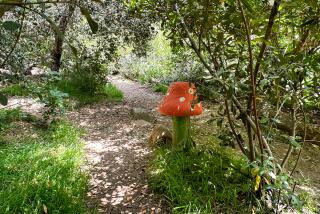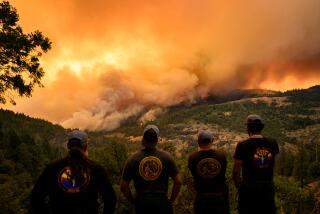Feds burn island weeds at Mono Lake to help birds feather their nests
LEE VINING, Calif. — A massive weed infestation on a tiny island at Mono Lake has choked out the nesting grounds that California gulls need to complete a life cycle as ancient as the million-year-old Sierra Nevada ecosystem.
On Friday, conservationists finally got their wish: a controlled burn aimed at destroying thousands of the nonnative spider-like plants.
The fire, set by federal firefighters, sent columns of gray smoke snaking up into the sky above the alkaline lake east of Yosemite National Park. The smoky haze cast an eerie pall over the famously lunar-like landscape of bizarre, craggy tufa formations, dormant volcanoes and jagged High Sierra granite peaks.
After the smoke cleared in the afternoon, nearly half of 11-acre Twain Island had been brought back to a semblance of its natural state of sand, gravel and rocks. Splotches of charred clumps of weeds covered the area like leopard spots.
Now, conservationists hope that gulls will take advantage of the newly created weed-free zones on the island to rear new generations of their species.
“With this effort, we’re essentially hanging up a sign for California gulls that says, ‘Ready for occupancy,’” said Kristie Nelson, a biologist and expert on the California gulls of Mono Lake.
“What happens next remains to be seen,” she added. “But we’re hoping that the breeding population of gulls will reverse the downward trend we’ve been seeing since the weeds invaded Twain Island about four years ago.”
The culprit is a bright-green, Eurasian bush scientists know as Bassia hyssopifolia. Although the plant, commonly known as five-horn smotherweed, is an annual, its spindly carcasses persist for years.
Nodding in appreciation toward a crew of six federal firefighters methodically igniting the waist-high weeds with drip torches, Jeff Karl, a forestry technician for the Inyo National Forest, smiled and said, “When it comes to burning, this operation is proceeding a lot better than I expected.”
“But we’re on a real learning curve here,” he said. “We’re dealing with a botanical invader about which little is known that is exploding across a unique and isolated micro-environment with its own micro-climate.”
“So, this treatment has to be the start of a long-time commitment based on lessons learned along the way,” he said. “Otherwise, these weeds might come back stronger than ever.”
The weeds disturbed the seasonal arrival of tens of thousands of intensely social ground-nesting gulls tussling over nesting turf on the island that had soothed the souls of birdwatchers and biologists alike in a state where nature is otherwise in retreat.
The weeds appeared in 2016 and exploded exponentially, quickly blanketing 70% of the gulls’ once-vibrant breeding grounds, casting off thousands of sticky seeds in the process.
“We were conducting annual nest counts on the island when we first noticed the weed population that had skyrocketed in a matter of months,” said Geoffrey McQuilkin, executive director of the Mono Lake Committee, a 40-year-old nonprofit conservation organization.
“We immediately reached out to the Forest Service for help in mobilizing a multi-agency response against an enemy that had caught us by surprise,” he said. “We were facing the potential loss of one of the three main nesting colonies of California gulls in the world.”
The largest number of gull nests ever recorded at Mono Lake was about 32,000 in the early 1990s. The number of nests has been in gradual decline since 2004, and in steep decline since the weeds showed up in 2016, biologists say.
In 2019, a total 11,075 nests were counted, the lowest number recorded over the 34-year course of one of the longest studies of birds in North America.
Scientists don’t know where the displaced gulls of Mono Lake are nesting now, if anywhere.
The controlled burn had been postponed for three consecutive years due to the logistical challenges posed by extreme fire seasons, winter storm systems, deep snowpack that prevented access to the islets, and gull breeding seasons.
In April, as snow begins to melt and weather conditions improve, Mono Lake’s islands officially become off-limits for the length of the five-month nesting season.
This week, U.S. Forest Service officials took advantage of a narrow window of opportunity based on the complexities of wildfire behavior, air pollution restrictions, weather conditions and fire containment strategies in a sparsely populated region that supplies High Sierra runoff to Los Angeles’ World War II-era aqueduct.
McQuilkin wants to see similar collaborative efforts conducted at four other islands used as nesting grounds by gulls and other birds including black-crowned night herons — all of which have come to depend on human help to save their offspring from drought, water diversions and the danger of ambush by hungry coyotes.
Healing and sustaining the Mono Lake ecosystem has been a decades-long battle. It began in the late 1970s, when the environmental impacts of L.A.’s aqueduct system, about 350 miles north of the city, were unavoidable.
Tributary streams dried up. The lake level had dropped more than 40 feet and the water had doubled in salinity, leaving behind smelly salt flats scoured by choking dust storms.
The sex lives of California gulls became a hot topic when the declining water level exposed a land bridge that connected an island gull rookery to the shore, allowing coyotes to pad across and feast on the birds and their eggs and offspring.
With support of the Audubon Society, the California National Guard attempted to blow up the land bridge with dynamite, but the targeted earth exploded sky high and then simply fell back into place.
The Forest Service in 1990 strung 1,100 yards of low-voltage wire across a portion of Mono Lake’s north shore in hopes a jolt would discourage coyotes from raiding the rookery. But the electronic barrier rapidly degraded in the corrosive alkaline foam and hypersaline water blowing off the lake.
In 1994, Los Angeles was ordered by state water officials to reduce the quantity of tributary water it had been diverting into the L.A. Aqueduct since 1941, ending a legal dispute that had pitted Los Angeles against the Audubon Society, trout anglers and the Mono Lake Committee.
“The ongoing weed war is only the latest chapter in the struggle to provide California gulls with all the creature comforts they need,” McQuilkin said.
Striding across the Twain Island shoreline on Friday, he reached out as if to embrace the smoldering landscape, smiled and said, “When the gulls return to consider raising new families on this very spot just 30 days from now, we believe they’re going to like what they see.”







